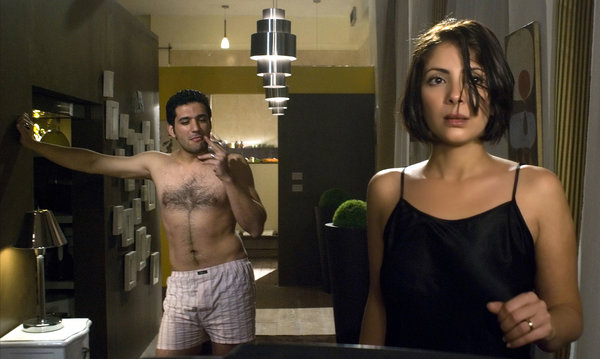The film “Scheherazade, Tell Me a Story” follows the story of married couple Hebba and Karim. Hebba works as a local reporter for a small television station, while Karim works for the government as one of the main editors. Karim is about to get a promotion, according to one of his colleagues who said he “saw it in a dream” (Scheherazade, Tell Me a Story). The story between both Hebba and Karim create the ultimate theme in the movie, of feminism trying to prevail past the bars of men and their personal greed. 
Specifically in Egyptian cinema, women have been called “feminists” (Shafik, Popular Egyptian Cinema); this certianly rings true for Hebba in the film. As she becomes a more experienced reporter, she begins to feel more and more comfortable about what she is reporting on, and she begins to develop her own means and aspirations. This contrasts heavily to other Arabic film, where women usually seem much more meek and powerless. Interestingly, Yousry plays up the power of women by showing Hebba’s resistance to the oncoming of Karim. He feels threatened by her work, as it would cause him to lose the promotion if she was to finsiher her work. Consistently, Hebba is able to focous on her own work without being persuaded, a message from the director on the increase of feminism in Egypt.
The fear of “female autonomy” seems to drive men within the film, as they consistently makes power moves to try and show dominance (New York Times). For example, three women are forced to fight for the love of one man, who turns out to be a traitor to all of the women; yet it seems as if he still has the power due to the noticeable superiority complex within the film. Therefore, this brings up another important message from the director: yes, feminism is healthy and women deserve the right to not be condescended upon; however, many are still forced into submission by men.
In the trailer for the movie, the conflicting gender roles are shown in a clearer context, as the entire trailer seems fixated upon different settings with men fighting against women. The trailer depicts the conflict that women go through, many being physically beaten and distraught; yet, Yousry Nasrallah somehow intertwines this violence and hatred with social justice at the climax at the movie that makes it feel as if Egyptian women are on the right track.
Overall, the role of women in Egyptian and Arabic cinema as a whole certainly is evolving. Shafik states that Egyptian film tends to be more advanced with the development of women, due to the countries own advancement with film industry (Shafik, History of Arab Cinema). To Nasrallah, women are just getting started with their transition to a higher power in society.
Works Cited
Catsoulis, Jeannette. “A TV Host seeks Fluff, but Real Life Intrudes”. New York Times. Web.
Dec 7, 2015.
Scheherazade Tell Me a Story. Dir. Yousry Nasrallah. Perf. Mona Zaki. 2009. Film.
Shafik, Viola. “The History of Arab Cinema.” Arab Cinema: History and Cultural Identity.
Meiffabudhabi. “Scheherazade, Tell Me A Story Trailer”. http://www.youtube.com. Web. Dec 7,
2015.
Shafik, Viola. “Popular Egyptian Cinema.” Gender, Class and Nation.


